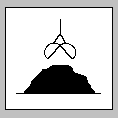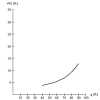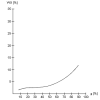| Peanuts | [German version] |
Table of contents |
|
| General: | ||
| Product information | ||
| Packaging | ||
| Transport | ||
| Container transport | ||
| Cargo securing | ||
Product information
Product name
| German | Erdnüsse, Arachisnüsse |
| English | Peanuts, groundnuts, earthnuts, monkey nuts |
| French | Arachides, Gland de terre |
| Spanish | Cacahuetes/manî (am.) |
| Scientific | Arachis hypogaea |
| CN/HS number * | 1202 ff. |
(* EU Combined Nomenclature/Harmonized System)
Product description
Peanuts are the leguminous fruits of an annual of the papilionaceous plant family (Leguminosae), growing underground (geocarpy) to a length of 2 – 6 cm. They have a thin, netted, wrinkly, fragile shell (pod) with 1 – 4 (generally 2) kernels, which are 1.5 – 2.5 cm in size. The shell fraction amounts to 25%.
The peanut is native to South America and is cultivated in all tropical and sub-tropical regions of the world. It is also called groundnut or earthnut.
Strictly speaking, peanuts are not true nuts, but rather are geocarpic legumes (i.e. legumes which grow underground). Since, owing to their high oil content, they have the same characteristics with regard to transport as nuts, they will be dealt with in this product group.
Peanuts are transported both shelled and unshelled. Peanut kernels are surrounded by a fine, brown seed coat, which contains antioxidants which protect the kernels against the penetration of atmospheric oxygen and thereby prevent them from becoming rancid (oxidative rancidity).
Oil content:
| 20 – 60% [1] | |
| 42 – 52% [2] | |
| 40 – 50% [3] |
Quality / Duration of storage
Peanuts are harvested and shipped all year round. The color and size of the peanuts vary depending on the country of origin, the color of the peanuts varying from light brown to red/reddish brown depending on the color of the soil; the lightest peanuts are the most desirable.
It is very important for the insurer to ascertain the year of harvest: it must be taken into consideration that the nuts may be mixed with nuts from the previous year’s harvest. Fresh peanut kernels have a smooth, shiny appearance. Old peanuts are dull and wrinkly. Peanuts from the previous year’s harvest have a tendency to insect infestation (beetles and moths) and rancidity. Thus, there is also an increased risk of aflatoxin production (see RF Toxicity/Hazards to health).
HPS stands for Hand Picked Selected.
Peanuts may be stored for two weeks in summer and several months in winter.
Intended use
As a legume with a high protein content (24 – 35%), the peanut is one of the world’s most important staple foods after wheat.
They are grown to be eaten fresh and for oil extraction (20 – 60% oil content). After soya oil, peanut oil occupies second place in world vegetable oil production. Peanuts are also used in the bakery and confectionery industries, as an ingredient in trail mixes, especially salted or unsalted as a snack food and as peanut butter.
Figures
(Click on the individual Figures to enlarge them.)
 Figure 1 |
 Figure 2 |
Countries of origin
This Table shows only a selection of the most important countries of origin and should not be thought of as exhaustive.
| Europe | Italy, Spain, Turkey |
| Africa | Nigeria, Sudan, Uganda |
| Asia | China, India, Israel, Taiwan, Burma, Indonesia, Japan |
| America | USA, Argentina, Brazil, Mexico |
| Australia |
Back to beginning
Packaging
These days, peanuts are mainly transported in containers. Conventional loading methods are now used only by China. Unshelled peanuts are predominantly packaged in polysacks in quantities of 25 – 30 kg (50 – 60 kg where shelled). Shelled peanuts for producing peanut oil, butter etc. are generally transported loose in bulk. Blanched peanut kernels are frequently packaged in 50 kg polysacks and unshelled nuts are also packaged in 10 kg cartons.
Back to beginning
Transport
Symbols
 General cargo |
 Bulk cargo |
Means of transport
Ship, truck, railroad
Container transport
Transport is also possible as bulk cargo in ventilated containers (coffee containers), if the water content of the goods is < 4.5% and the lower limits set for the water content of packaging and flooring and the oil content of the goods are complied with and if protection against solar radiation is ensured (-> self-heating).
Cargo handling
In damp weather (rain, snow), the cargo must be protected from moisture, since it may lead to mold, spoilage and self-heating as a result of increased respiratory activity.
No hooks should be used with bagged cargo, so as to prevent damage to the bags and loss of volume.
Stowage factor
Unshelled:
| 3.34 – 3.62 m3/t (jute bags) [1] | |
| 3.55 m3/t (bulk) [1] | |
| 2.83 – 3.31 m3/t (bulk) [14] | |
| 3.09 – 3.68 m3/t (bags) [14] |
Shelled:
| 1.78 – 1.81 m3/t (jute bags) [1] | |
| 2.35 – 2.44 m3/t (boxes and cartons) [14] |
Stowage space requirements
Stow below deck, in cool, dry, well ventilated conditions and not on heated double bottom tanks
Segregation
Fiber rope, thin fiber nets (general cargo), tarpaulins, no plastic films (bulk cargo)
Cargo securing
In order to ensure safe transport, the bags must be stowed and secured in the means of transport in such a manner that they cannot slip or shift during transport. Attention must also be paid to stowage patterns which may be required as a result of special considerations, such as ventilation measures.
In the event of loading as general cargo, dunnage should be used to protect against damage:
| Floor dunnage: criss-cross dunnage and packing paper | |
| Side dunnage: lining with wooden dunnage and mats or jute coverings: protection from metal parts of the ship, since traces of metal promote cargo rancidity due to autoxidation. | |
| Top dunnage: important for voyages to cold regions (winter), since sweat may drip onto the cargo. |
Back to beginning
Risk factors and loss prevention
RF Temperature
Peanuts require particular temperature, humidity/moisture and ventilation conditions (SC VII) (storage climate conditions).
Favorable travel temperature range: 5 – 25°C [1]
At temperatures < 5°C, fresh cargo is subject to cold damage and spoilage. Temperatures > 30°C should not prevail for a long period, as such temperatures promote respiration of the cargo. Heated nuts become rancid and thus inedible.
Low temperatures can only limit hydrolytic/enzymatic fat cleavage and cargo respiration. It is therefore of primary importance to ensure storage stability by compliance with water content limit values (see Risk factor Humidity/Moisture).
The following Figure shows a typical temperature profile for shipment of bagged peanut kernels from China:
 Figure 6 |
Back to beginning
RF Humidity/Moisture
Peanuts require particular temperature, humidity/moisture and ventilation conditions (SC VII) (storage climate conditions).
| Designation | Humidity/water content | Source |
| Relative humidity | 65% | [1] |
| Water content | 4.5 – 5.5% (unshelled) | [1] |
| 4 – 10% (shelled) | [1] | |
| 4 – 7% | [2] | |
| 8 – 10% | [14] | |
| Maximum equilibrium moisture content | 65% | [1] |
Cargo which has become moist exhibits increased hydrolytic/enzymatic fat cleavage, which leads to self-heating as a result of increased respiration.
Peanuts are very sensitive to moisture of any kind (sea, rain, condensation water). Peanuts which have become too moist have a tendency to develop mold (Caution: formation of aflatoxin). With bagged loads, the dunnage or the container must be dry and the bags must not be stowed directly against metal parts to protect them from hold or container sweat.
The sorption isotherm for unshelled peanuts shows that they are strongly hygroscopic (hygroscopicity): even at relative humidity of 60%, the peanut water content reaches almost 10%. The curve rises steeply, for example a 12% water content is at equilibrium with a relative humidity of 75%. This means that the mold growth threshold is reached. The steep rise exhibited by the sorption isotherm may be explained by the porosity of the shells. The sorption isotherm for peanut kernels shows that, at a water content of 8%, the mold growth threshold is reached at an equilibrium moisture content of 75%.
 Figure 3 |
 Figure 4 |
 Figure 5 |
Back to beginning
RF Ventilation
Peanuts require particular temperature, humidity/moisture and ventilation conditions (SC VII) (storage climate conditions).
Recommended ventilation conditions: air exchange rate: at least 10 changes/hour (airing)
The heat arising through self-heating of the cargo must be dissipated as quickly as possible by ventilation, since hot spots spread very rapidly and may affect entire batches of cargo. If the cargo is loaded with a relatively high water content, heat dissipation must be assisted by suitable stowage measures and ventilation channels. Absolutely fresh, green peanuts are frequently the cause of cargo fires.
Before anybody enters the hold, it must be checked for an excessive CO2 content due to cargo respiration and, if necessary, ventilated.
Back to beginning
RF Biotic activity
Peanuts display 2nd order biotic activity.
They are living organs in which respiration processes predominate, because their supply of new nutrients has been cut off by separation from the parent plant.
Care of the cargo during the voyage must be aimed at keeping decomposition processes at the lowest possible level, so as to keep within limits any losses in quality caused by the emission of CO2, heat and water vapor.
Back to beginning
RF Gases
In peanuts (particularly fresh goods), metabolic processes continue even after harvesting. They absorb oxygen and excrete carbon dioxide (CO2).
If ventilation has been inadequate (frost) or has failed owing to a defect, life-threatening CO2 concentrations or O2 shortages may arise. Therefore, before anybody enters the hold, it must be ventilated and a gas measurement carried out. The TLV for CO2 concentration is 0.49 vol.%.
Back to beginning
RF Self-heating / Spontaneous combustion
Fresh, green, wet, crushed peanuts with a high water content tend in particular towards rapid self-heating, may ignite and thus behave like a substance from Class 4.2 of the IMDG Code and lead to cargo fires.
Oil content:
| 20 – 60% [1] | |
| 42 – 52% [2] | |
| 40 – 50% [3] |
Fat decomposition in nuts leads to the risk of self-heating and, finally, to a cargo fire.
Fat decomposition may proceed as follows:
| by hydrolytic/enzymatic fat cleavage or | |
| by oxidative fat cleavage |
Hydrolytic/enzymatic fat cleavage:
If the critical water content of the peanuts is exceeded, this promotes hydrolytic/enzymatic fat cleavage. Fat-cleaving enzymes are activated by the elevated water content. The additional action of light and heat may accelerate this process. Free fatty acids sometimes have an unpleasant odor and taste. In the event of extended storage or improper cargo care, these cause the cargo to become rancid.
The free fatty acids formed are consumed by respiration processes in the peanuts to form carbon dioxide and water, a process which is associated with considerable evolution of heat.
Self-heating of peanuts is an extremely vigorous process, as the consumption of fatty acids by respiration processes is associated with a considerably greater evolution of heat than is the case with the respiration equation for carbohydrates. Here too, as with cereals, the spoilage process proceeds in a type of chain reaction, because heat and water are formed by the fatty acids consumed by respiration, which in turn contribute to an intensification of the process.
The self-heating of peanuts requires only a small seat of moisture, so that within just a few hours heating may occur at moist points for which weeks or months would be required in goods dry on shipment.
Fresh peanuts with a high water content tend in particular towards rapid self-heating and may ignite. Self-heating of peanuts leads not only to a reduction in the utility value of this product (rancid odor and taste) but also has a qualitative and quantitative effect on oil yield. The color and bleachability of the oils are also negatively affected. The oil obtained complicates refining of the crude oils in subsequent processing, because a higher free fatty acid content makes decolorization substantially more difficult.
Hydrolytic/enzymatic fat cleavage and respiration may be limited by low temperatures; however, this may only be affected to a limited degree during transport. It is therefore important to ensure storage stability by complying with the limit values for the water content of the goods.
Oxidative fat cleavage:
Food components frequently react with atmospheric oxygen in spoilage reactions. Atmospheric oxygen may enter into an addition reaction with unsaturated fatty acids through the simultaneous assistance of light, heat and certain fat companion substances. Rancidity caused by oxidative fat cleavage is particularly noticeable in the case of shelled peanuts, because the shelling process results to a certain degree in exposure to atmospheric oxygen or to the steel parts of the ship or the container walls, if not carefully covered with mats. It is therefore absolutely essential to store peanuts in the dark and to protect them from oxygen and metal parts, since otherwise they become brown-colored and develop a rancid odor and taste.
Back to beginning
RF Odor
| Active behavior | Peanuts have a very slight, pleasant odor. |
| Passive behavior | Sensitive to unpleasant and/or pungent odors. |
Back to beginning
RF Contamination
| Active behavior | As a result of the high oil content of the goods, dark fat spots may appear on the bags, which must therefore not come into contact with contamination-sensitive goods. Do not stow together with fibers/fibrous materials, since oil-impregnated fibers promote self-heating. |
| Passive behavior | Peanuts themselves are sensitive to dust, dirt and fats and oils. In the case of relatively large consignments, it is advisable to commission an independent surveyor to monitor stowage and inspect the holds with regard to cleanliness, absence of odor, sealing of hatches and ventilation equipment. |
Back to beginning
RF Mechanical influences
Peanuts are impact- and pressure-sensitive. If stack pressure is too high, the peanuts are crushed, thereby promoting self-heating. In addition, if the nuts are transported in jute bags, the oils accumulate in the fabric and accelerate the process.
Back to beginning
RF Toxicity / Hazards to health
The molds Aspergillus flavus and Aspergillus parasiticus produce the toxin aflatoxin, which may be present in the cargo as a result of an attack by the above-mentioned mold types. In general, this is „country damage“, i.e. the toxin is already present in the peanut at the time of harvesting. As a rule, aflatoxin is only found in individual nuts. If batches of peanuts intended as a human foodstuff are affected by this toxin, the product can no longer be approved for human consumption. Peanuts affected by aflatoxin cannot be distinguished with the naked eye from the other nuts in a batch. The toxin may be detected using UV light.
Back to beginning
RF Shrinkage/Shortage
Volume may be lost as a result of tears in bags and theft.
A weight loss of approximately 1 – 2% is deemed normal. Larger weight losses may arise in the event of water vapor emission by fresh, green or excessively wet goods. New crop unshelled peanuts may weigh 12% heavier, for example in April, than those warehoused in December.
Valuable cargo, so at high risk of theft.
Back to beginning
RF Insect infestation / Diseases
Insect infestation generally occurs during storage prior to loading and may cause considerable damage, in particular to kernels.
Insect infestation should therefore be looked for when a consignment is accepted, since peanuts are generally infested (grain moths, khapra beetles, flour beetles, mites, cockroaches, sawtoothed grain beetles, meal moths, dried fruit moths and rats and mice).
Commission a loading inspector, have reserve samples taken and sealed.
The quarantine regulations of the country of destination must be complied with and a phytosanitary certificate and fumigation certificate may have to be enclosed with the shipping documents. Information may be obtained from the phytosanitary authorities of the countries concerned.
Back to beginning
